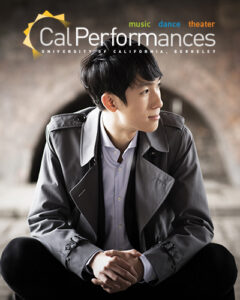Eric Lu, piano
Sunday, February 6, 2022, 3pm
Hertz Hall
The run time for this performance is approximately 1 hour and 45 minutes, with intermission.
This performance is made possible, in part, by Patron Sponsors Marian Lever & Art Berliner.
From the Executive and Artistic Director

February marks the time each year when Cal Performances’ programming shifts into high gear. From now through the beginning of May, the remainder of our 2021–22 season is packed with ambitious and adventurous programming. You won’t want to miss…
- sensational dance performances like Memphis Jookin’: The Show, featuring Lil Buck (Feb 25–26); The Joffrey Ballet (Mar 4–6); and the Alvin Ailey American Dance Theater (Mar 29 – Apr 3)
- the West Coast premiere (Mar 12) of Place, Ted Hearne and Saul Williams’ bold meditation on the topographies of gentrification and displacement, a Cal Performances Illuminations “Place and Displacement” event (see website for more details)
- the renowned English Baroque Soloists with conductor Sir John Eliot Gardiner in a transfixing program of works by Mozart and Haydn (Apr 10)
- the peerless London Symphony Orchestra (Mar 20), appearing under the direction of superstar conductor Simon Rattle in a program of orchestral masterworks
- pianist extraordinaire Mitsuko Uchida with the Mahler Chamber Orchestra (Mar 27)
- our 2021–22 artist-in-residence Angélique Kidjo in her brand new music-theater piece Yemandja (a highly anticipated Cal Performances co-commission and Illuminations event, Apr 23).
Fasten your seatbelts; we have all of this—plus much more—in store for you!
While we at Cal Performances like to think of each of our programs as unique and remarkable, two February offerings, in particular, stand out as season highlights. On February 12 at 8pm at Zellerbach Hall, a living legend of jazz collaborates with one of the brightest lights of the younger generation in the West Coast premiere of Wayne Shorter & esperanza spalding’s …(Iphigenia), a Cal Performances co-commission that reimagines what opera can be and asks us to reexamine the stories we have inherited and the choices we make as a society. Shorter has written the music and spalding is the librettist and appears in the title role in this radical new take on Euripides’ ancient Greek play Iphigenia in Aulis. Seats for this highly anticipated performance sold out weeks ago, so congratulations to you lucky ticket holders! (To sign up for a waiting list for returned tickets, please visit the event page on our website.)
Then, just a few days later (Feb 17, Zellerbach Hall), co-producers and stars Alicia Hall Moran (mezzo-soprano) and Jason Moran (piano) arrive on campus for the West Coast premiere of their brilliant Two Wings: The Music of Black America in Migration (another Cal Performances Illuminations event), a series of “gripping portraits of a vast social upheaval” (Chicago Tribune) that explores the Great Migration of six million Black Americans from the rural South to northern cities, the West, and beyond. This ambitious production features a star-studded roster of guest performers, writers, and thinkers, headed by composer/conductor (and 2021 winner of the Pulitzer Prize for Music) Tania León, narrator Donna Jean Murch (author of Living for the City), and the Imani Winds chamber ensemble (to name just a few!). Together, these exceptional artists trace the Morans’ family histories through the music that accompanied their brave antecedents throughout the 20th century, from Harlem Renaissance-era jazz, gospel hymns, and Broadway show tunes, to classical and chamber music and the artists’ own compositions.
We’re very proud of our new and updated winter brochure and know that a few minutes spent reviewing our schedule—in print or online—will reveal a wealth of options for your calendar; now is the perfect time to guarantee that you have the best seats for all the events you plan to attend.
I know you join us in looking forward to what lies ahead, to coming together once again to
encounter the life-changing experiences that only the live performing arts deliver. We can’t wait to share it all with you during the coming months.
Jeremy Geffen
Executive and Artistic Director, Cal Performances
 February marks the time each year when Cal Performances’ programming shifts into high gear. From now through the beginning of May, the remainder of our 2021–22 season is packed with ambitious and adventurous programming. You won’t want to miss…
February marks the time each year when Cal Performances’ programming shifts into high gear. From now through the beginning of May, the remainder of our 2021–22 season is packed with ambitious and adventurous programming. You won’t want to miss…
- sensational dance performances like Memphis Jookin’: The Show, featuring Lil Buck (Feb 25–26); The Joffrey Ballet (Mar 4–6); and the Alvin Ailey American Dance Theater (Mar 29 – Apr 3)
- the West Coast premiere (Mar 12) of Place, Ted Hearne and Saul Williams’ bold meditation on the topographies of gentrification and displacement, a Cal Performances Illuminations “Place and Displacement” event
- the renowned English Baroque Soloists with conductor Sir John Eliot Gardiner in a transfixing program of works by Mozart and Haydn (Apr 10)
- the peerless London Symphony Orchestra (Mar 20), appearing under the direction of superstar conductor Simon Rattle in a program of orchestral masterworks
- pianist extraordinaire Mitsuko Uchida with the Mahler Chamber Orchestra (Mar 27)
- our 2021–22 artist-in-residence Angélique Kidjo in her brand new music-theater piece Yemandja (a highly anticipated Cal Performances co-commission and Illuminations event, Apr 23).
Fasten your seatbelts; we have all of this—plus much more—in store for you!
While we at Cal Performances like to think of each of our programs as unique and remarkable, two February offerings, in particular, stand out as season highlights. On February 12 at 8pm at Zellerbach Hall, a living legend of jazz collaborates with one of the brightest lights of the younger generation in the West Coast premiere of Wayne Shorter & esperanza spalding’s …(Iphigenia), a Cal Performances co-commission that reimagines what opera can be and asks us to reexamine the stories we have inherited and the choices we make as a society. Shorter has written the music and spalding is the librettist and appears in the title role in this radical new take on Euripides’ ancient Greek play Iphigenia in Aulis. Seats for this highly anticipated performance sold out weeks ago, so congratulations to you lucky ticket holders! (To sign up for a waiting list for returned tickets, please visit the event page on our website.)
Then, just a few days later (Feb 17, Zellerbach Hall), co-producers and stars Alicia Hall Moran (mezzo-soprano) and Jason Moran (piano) arrive on campus for the West Coast premiere of their brilliant Two Wings: The Music of Black America in Migration (another Cal Performances Illuminations event), a series of “gripping portraits of a vast social upheaval” (Chicago Tribune) that explores the Great Migration of six million Black Americans from the rural South to northern cities, the West, and beyond. This ambitious production features a star-studded roster of guest performers, writers, and thinkers, headed by composer/conductor (and 2021 winner of the Pulitzer Prize for Music) Tania León, narrator Donna Jean Murch (author of Living for the City), and the Imani Winds chamber ensemble (to name just a few!). Together, these exceptional artists trace the Morans’ family histories through the music that accompanied their brave antecedents throughout the 20th century, from Harlem Renaissance-era jazz, gospel hymns, and Broadway show tunes, to classical and chamber music and the artists’ own compositions.
We’re very proud of our new and updated winter brochure and know that a few minutes spent reviewing our schedule—in print or online—will reveal a wealth of options for your calendar; now is the perfect time to guarantee that you have the best seats for all the events you plan to attend.
I know you join us in looking forward to what lies ahead, to coming together once again to encounter the life-changing experiences that only the live performing arts deliver. We can’t wait to share it all with you during the coming months.
Jeremy Geffen
Executive and Artistic Director, Cal Performances




